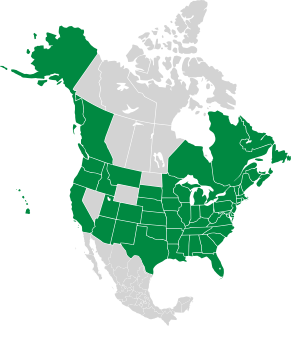Acetosa oblongifolia (L.) Á. Löve & D. Löve
Rumex obtusifolius L. ssp. agrestis (Fr.) Danser
Rumex obtusifolius L. ssp. sylvestris (Wallr.) Rech. f.
Rumex obtusifolius L. var. sylvestris (Wallr.) Koch

|
Rumex obtusifolius L. Bitter dock, broad-leaved dock, bitter dock. broad-leaved dock
Native to western Europe, broadleaf dock is now widespread in North America. It prefers ditches, roadsides, wetlands, meadows, riparian areas, alfalfa and pasture fields (especially with poor drainage), orchards and other disturbed moist areas. Plants: 1-4′ (30-121 cm), on stout stems that don’t branch except just below the flowerheads. Leaves: Basal leaves are not arranged in a rosette, and are oval, oblong, or heart-shaped, usually red-veined.. Upper leaves are lanceolate. All leaves have wavy edges, but less so than with curly dock. Flowers: On spike-like racemes, greenish, pinkish, or reddish. They appear from June to October. Fruits: ~1/16″ (2-2.7 mm), comprised of triangular “valves" (wings), each with 2-4 spiny teeth on margins. One of the three wings has a seed. These are closely similar: |
7/3/2012 · Yellow Trail from Pearl Hill State Park to Willard Brook State Park, Ashby, Massachusetts · ≈ 1 × 1½′ (34 × 52 cm) 7/17/2009 · Mt. Lebanon St, Trail, Pepperell, Massachusetts · ≈ 1½ × 2½′ (55 × 82 cm) |
||||||||||||||||||||||||||||
|
| |||||||||||||||||||||||||||||
Rumex crispus |
You are here Rumex obtusifolius |
||||||||||||||||||||||||||||
|---|---|---|---|---|---|---|---|---|---|---|---|---|---|---|---|---|---|---|---|---|---|---|---|---|---|---|---|---|---|
| Common Name |  |
 |
|||||||||||||||||||||||||||
| Plant | 12-55″ (30-140 cm) in height, erect but with a few branches. | 1-4′ (30-121 cm), on stout stems that don’t branch except just below the flowerheads. | |||||||||||||||||||||||||||
| Flowers | A panicle of racemes of whorls of flowers appears at the upper 6-18″ (15-45 cm). (In other words, there are a whole pile of tiny, greenish, weird-looking flowers.) Each yellowish or reddish green flower is about ⅛″ (3.2 mm) long. If you look closely, it consists of 3 inner sepals, 3 outer sepals, 3 styles, and an ovary. | On spike-like racemes, greenish, pinkish, or reddish. They appear from June to October. | |||||||||||||||||||||||||||
| Leaves | A large basal rosette about 1′ (30 cm) around consists of smooth-edged, distinctively wavy (“crisped”) alternate leaves. Each leaf is up to 6″ (15 cm) × 1″ (2.5 cm), oblong-lanceolate in shape, and hairless. | Basal leaves are not arranged in a rosette, and are oval, oblong, or heart-shaped, usually red-veined.. Upper leaves are lanceolate. All leaves have wavy edges, but less so than with curly dock. | |||||||||||||||||||||||||||
| Fruit | Each flower becomes a heart-shaped, toothless fruit 1/16-⅛″ (2-4 mm) that contains a single white seed that matures to dark brown. | ~1/16″ (2-2.7 mm), comprised of triangular “valves" (wings), each with 2-4 spiny teeth on margins. One of the three wings has a seed. | |||||||||||||||||||||||||||
| Range/ Zones |
|
|
|||||||||||||||||||||||||||
| Habitats | Disturbed habitats, railroad beds, fallow fields, ocean beaches, and other wetland margins. | Ditches, roadsides, wetlands, meadows, riparian areas, alfalfa and pasture fields (especially with poor drainage), orchards and other disturbed moist areas. | |||||||||||||||||||||||||||
| Type | Wild | Wild | |||||||||||||||||||||||||||
| Occurrence | Common | Common | |||||||||||||||||||||||||||
Edibility: Poisonous ![]() Fairly high levels of oxalic acid make this plant
poisonous. Young leaves are sometimes cooked with at least one change of water to reduce levels of oxalic acid
(and the associated bitterness). Green Deane at EatTheWeeds.com writes “Mainer Merritt Fernald, who was the Harvard wunderkind of botany from around 1900 to 1950, said all of the 17 native Rumex species in North America were edible. He completely failed to mention most of them are so bitter it would take days of boiling to make them palatable, if ever." He nevertheless goes on
to discuss the culinary properties of the Rumex genus.
Fairly high levels of oxalic acid make this plant
poisonous. Young leaves are sometimes cooked with at least one change of water to reduce levels of oxalic acid
(and the associated bitterness). Green Deane at EatTheWeeds.com writes “Mainer Merritt Fernald, who was the Harvard wunderkind of botany from around 1900 to 1950, said all of the 17 native Rumex species in North America were edible. He completely failed to mention most of them are so bitter it would take days of boiling to make them palatable, if ever." He nevertheless goes on
to discuss the culinary properties of the Rumex genus.
Medical: No proven uses.
Online References:
The University of Massachusetts Landscape, Nursery & Urban Forestry Program
Plants for a Future, a resource and information centre for edible and otherwise useful plants
References:
Clemants, Steven; Gracie, Carol, Wildflowers in the Field and Forest, Oxford University Press, 2006, p. 232
6/13/2016 · Nashua River Rail Trail, Groton, Groton, Massachusetts ![]() ID is uncertain
ID is uncertain 
4/7/2010 · Nashua River Rail Trail, Groton, Massachusetts · ≈ 15 × 10″ (39 × 26 cm) ![]() ID is uncertain
ID is uncertain 
4/6/2010 · Nashua River Rail Trail, Groton, Massachusetts · ≈ 1½ × 1′ (52 × 34 cm) ![]() ID is uncertain
ID is uncertain 
4/14/2010 · Mt. Lebanon St., Pepperell, Massachusetts · ≈ 8 × 12″ (20 × 31 cm) 
Acetosa oblongifolia (L.) Á. Löve & D. Löve
Rumex obtusifolius L. ssp. agrestis (Fr.) Danser
Rumex obtusifolius L. ssp. sylvestris (Wallr.) Rech. f.
Rumex obtusifolius L. var. sylvestris (Wallr.) Koch
Rumex obtusifolius description by Thomas H. Kent, last updated 25 May 2020.
© FloraFinder.org. All rights reserved.
7/3/2012 · Yellow Trail from Pearl Hill State Park to Willard Brook State Park, Ashby, Massachusetts · ≈ 12 × 17″ (29 × 44 cm) 
7/3/2012 · Yellow Trail from Pearl Hill State Park to Willard Brook State Park, Ashby, Massachusetts · ≈ 12 × 17″ (29 × 44 cm) 
7/3/2012 · Yellow Trail from Pearl Hill State Park to Willard Brook State Park, Ashby, Massachusetts · ≈ 12 × 17″ (29 × 44 cm) 
4/13/2010 · Nashua River Rail Trail, Groton Center, Groton, Massachusetts · ≈ 7 × 11″ (18 × 27 cm) 
Range:
